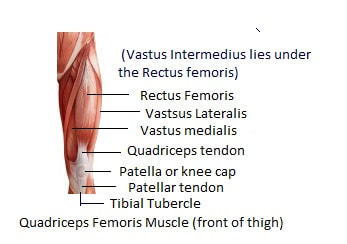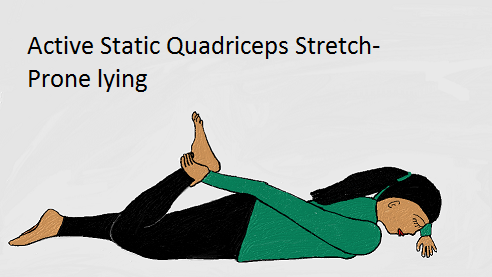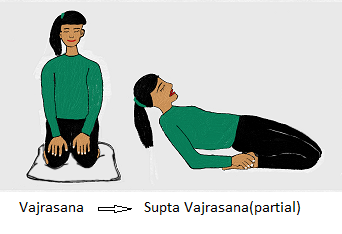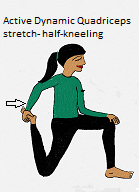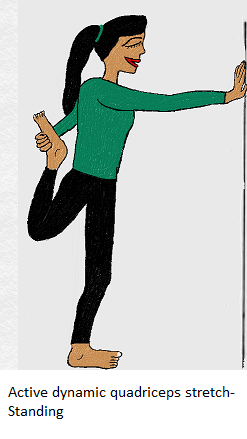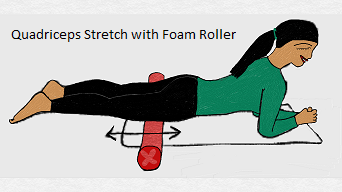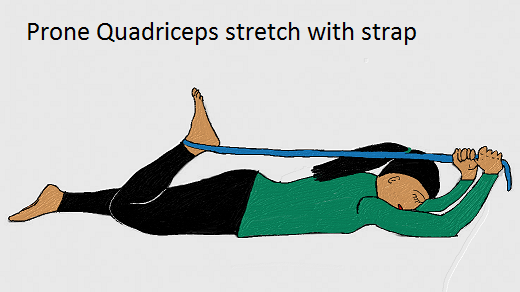|
We went through the Hamstrings stretch last week. Can Quadriceps stretch be far away?
All right, here it is. • The quadriceps muscle is the major bulk of muscle you feel/ see in front of the thigh. • It is made up of the three vastii muscles and the rectus femoris. • The vastus lateralis, vastus medialis, and vastus intermedius originate from the femur bone. • The rectus femoris originates from the AIIS (anterior inferior iliac spine), a bony prominence of the iliac bone (to refresh, the ilium is one of the three pelvic bones, the other two being the ischium and pubis). • As the name suggest, the vastus lateralis is on the lateral or outer side of the thigh, the vastus medialis is on the medial or inner side of the thigh, and the vastus intermedius is a deep muscle that lies in between these two muscles in the middle of the thigh. The vastii are single joint muscles and their function is to straighten the knee joint or knee extension as it is termed. • The rectus femoris is a superficial and large muscle that lies over the vastus intermedius and portions of the vastus lateralis and medius. Since it crosses both the hip joint and knee joint, its function is to flex the hip joint and extend the knee joint. • Just above the knee joint, the above muscles unite to form a common quadriceps tendon. The knee cap is embedded within the quadriceps tendon and this continues as the patellar tendon (below the patella) to insert on the tibial (lower leg bone) tuberosity. • The vastus medialis obliquus (VMO) is part of the vastus medialis muscle whose short fibers run obliquely and plays a key role in patellar tracking and stabilization. As with any exercise, movement and stability are key, even with stretches. It is important to be aware of the dynamic postures as you attain and hold the stretch position. Repetition of good postures while stretching, lead to increased flexibility and general wellness. However, after achieving the increased range, it is imperative to incorporate the newly acquired movement in activities to develop motor control. Hence stretches should be part of exercise program and not just done as a stand -alone exercise. Another important point to be mentioned here is that muscles and soft tissue stretch better when warm, and warm-up exercise prior to deepening stretches help to achieve personal best. The different ways to stretch the Quadriceps are: (as usual we will consider stretching the right quadriceps for ease of understanding) 1) Passive stretch: this can be done in the prone position with the therapist flexing or bending the knee with the hip stabilized on the mat in neutral position. One arm stabilizes the pelvis, while the other flexes the knee joint till stretch is felt. The position is held from 5 seconds to 30 seconds (as long as possible) and released with 15-30 second rest in between. 2) Active static stretch: i) This stretch is similar to the passive stretch above in prone position and the person may actively bend the knee to feel a stretch in front of the thigh, while the pelvis is stabilized by the mat/bed. The right hand may grasp the right foot/ankle to deepen the knee flexion for further stretch. ii) One of the advanced yoga asana called the supta vajrasana effectively stretches the quadriceps with the knee in full flexion, while lowering the torso (back down) onto the mat. It is important to keep the knees on the floor and not allow them to lift up by flexing the hip joints. Also, the abdominals and back extensors co-contract to keep the spine stable and elongated. It is okay to rest on forearms if stretch is already felt in front of thigh. As you advance deeper into this pose, the shoulder blades lie on the mat with lumbar spine in minimal extension to neutral position. When the rectus or hip flexors are tight, it may cause anterior pelvic tilt and lumbar extension increasing the lumbar curve. So watch out for that and progress slowly. In case of anterior pelvic tilt of increased lumbar lordosis, prone position is ideal to stabilize the pelvis and prevent anterior tilt, till sufficient length is achieved in the quadriceps. 3) Active Dynamic stretch: i) Standing position near wall: With the pelvis neutral in standing position, extend the right hip while flexing the knee and hold the right ankle/foot with the right hand. The left hand may be used for support on wall if needed. ii) Half-kneeling position on mat or floor. A forward lunge in half-kneeling stretches the rectus femoris primarily, and may be modified to deepen the vastii stretch by further flexing the right knee while lifting the right foot off the floor. The right hand may be used to hold the right ankle/foot. It demands balance as well as stability at trunk and hip joints. 4) Stretch using tools/equipment: i) In prone position using a strap/gait belt: lie with face down on mat/bed with the strap or gait belt tied above the ankle and bend the right knee bringing the right heel to the right buttock. The other end of the strap/belt passes over the right shoulder and is pulled with the right hand to deepen the stretch. ii) In standing position near a wall, a stool can be used to rest the right knee. Position the left hand on the wall for support in front. Slowly flex the right knee as far as possible. A strap may be looped around the ankle with the other end passing over the right shoulder and using the right hand to pull down on strap to deepen stretch. iii) With the foam roller on the floor, lie on the foam roller, face down on the front of the thighs and rest the forearms on the floor. You may keep the legs straight while rolling the foam roll back and forth along the front of thigh in small segments or hold the position where you sense a tender spot and slowly flex and extend the knee, allowing the pressure from body weight to release the tightness
0 Comments
Your comment will be posted after it is approved.
Leave a Reply. |
Details
AuthorAmi Gandhi is a licensed physical therapist in the state of California. She is the owner of StableMovement Physical Therapy, a small boutique practice in San Jose that offers patient centered, one-on-one, hands-on physical therapy. Archives
March 2018
Categories |
